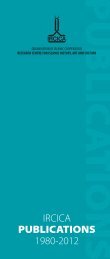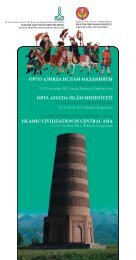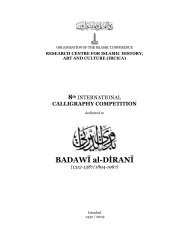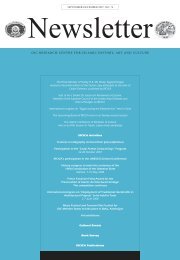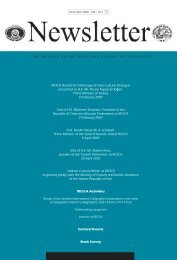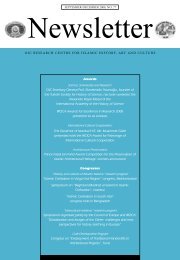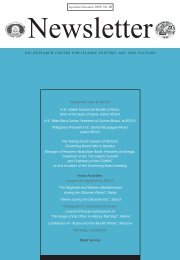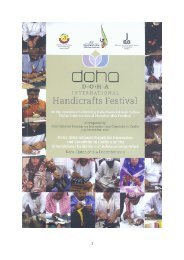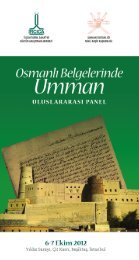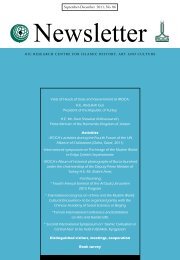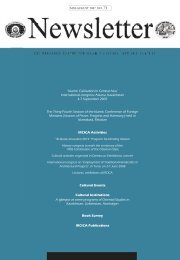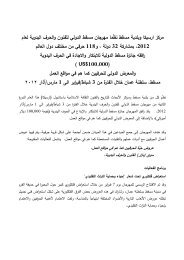IRCICA Newsletter, issue 82-83
IRCICA Newsletter, issue 82-83
IRCICA Newsletter, issue 82-83
You also want an ePaper? Increase the reach of your titles
YUMPU automatically turns print PDFs into web optimized ePapers that Google loves.
Osmanlı Belgelerinde Arap Vilayetleri.<br />
XVI. Yüzyılın İlk Yarısı<br />
(The Arab provinces in Ottoman documents.<br />
First half of the 16th century)<br />
Preparation, Translation and Study by Fazıl Bayat,<br />
Vol. I, <strong>IRCICA</strong>; Istanbul, 2010, XXXVI, 412, XVI p.<br />
(in Arabic and Turkish)<br />
This book is the first<br />
volume of a series<br />
being prepared by Dr.<br />
Fazıl Bayat (<strong>IRCICA</strong>) in<br />
the Arabic language to<br />
serve researchers in the<br />
history of the Ottoman<br />
period. The Ottoman<br />
official documents are<br />
invaluable references for<br />
studies on the history of<br />
the countries which were<br />
once part of the Empire as<br />
well as of the Empire itself.<br />
These documents are preserved in the Department of Ottoman<br />
Archives in Istanbul attached to the Turkish Prime Ministry’s<br />
Directorate General of State Archives, other State archives,<br />
including the Topkapı Palace Museum. In this research<br />
project, documents relating to the Arab lands on subjects such<br />
as administrative history, rural development efforts, public<br />
works, public health, education, science and scholarship, press<br />
and publications, are compiled and translated into Arabic<br />
and published together with the Latin-script transcriptions<br />
of the texts in Ottoman Turkish. This first volume contains<br />
104 documents in total selected from the Muhimme registers<br />
of the 15th and 16th centuries. The original text of each<br />
document is presented side by side with its Arabic translation<br />
where the reader can see the excellent loyalty of the latter to<br />
the former. Furthermore, the author examined and analysed<br />
each document, outlined it in a simplified form, and added<br />
clarifications whenever necessary to facilitate comprehension.<br />
The documents are presented in eleven sections, titled<br />
according to places or subjects, but also taking into account<br />
their contents. The documents show a large diversity: there is<br />
correspondence between the Ottoman and Mamluk sultans,<br />
documents relating to the reign of Sultan Selim I, the phase<br />
preceding the conquest of Baghdad, Mecca and pilgrimage,<br />
Yemen and the Red Sea, North Africa, waqfs and religious<br />
affairs, petitions submitted to the Sublime Porte, foreign<br />
tradesmen and tourists, administrative, foreign, financial and<br />
military affairs. Two sets of ruznames (daily records, journals)<br />
are annexed: those relating to Sultan Selim I’s campaign to<br />
Syria and Egypt, and Sultan Suleyman’s campaign to Iraq. The<br />
volume reflects the expertise and meticulousness of its author.<br />
The series will continue with subsequent volumes to result<br />
from this project.<br />
<strong>IRCICA</strong> Publications<br />
Tatar History and Civilisation<br />
Edited by Damir Ishaqov, Project Director: Halit Eren,<br />
Project Advisors: M.A. Usmanov, R.S. Khakimov,<br />
translated by Ilnur I. Nadirov, <strong>IRCICA</strong>, 2010<br />
This is a rich and comprehensive book on the history and<br />
civilization of the Tatars and the first to be published<br />
in the English language. It is a collaborative work in which<br />
35 scholars from Tatarstan participated. The book begins<br />
with the comprehensive Introduction by Dr. Damir Ishaqov<br />
titled “The Tatar World: Ethnos, Culture and Language”. It is<br />
followed by Part I on History, containing 10 chapters. This part<br />
evaluates the historical transformation of Tatar society and<br />
institutions from pre-Islamic times to the post-Soviet era. Part<br />
II on Social Structure and Economic Development in Tatar<br />
Society, which has six chapters, focus on the social structure,<br />
economic development and daily life of Tatar community. Part<br />
III on Culture, with 10 chapters, covers the evolution of Tatar<br />
language, educational institutions, arts and culture. Each part<br />
ends with a section of photographs. The book was originally<br />
prepared in the Tatar language under the coordination of<br />
<strong>IRCICA</strong> Director General Dr. Halit Eren and the scholarly<br />
advice of Professors Mirkasim A. Usmanov and Rafael S.<br />
Khakimov; it was translated into English by Ilnur Nadirov, and<br />
prepared for publication at <strong>IRCICA</strong>.<br />
Knowledge of Tatar history and civilization around the world<br />
was until recently confined to a limited circle of specialists.<br />
However interest in the subject has been growing recently as<br />
is reflected through the <strong>IRCICA</strong> conferences on Volga-Ural<br />
history and civilization among others. The Conclusion by Prof.<br />
Rafael Khakimov points to the importance of the Tatar factor<br />
in understanding the history of Russia and the whole world.<br />
<strong>IRCICA</strong> believes that the present publication will contribute<br />
importantly in this direction. Research and learning interest<br />
about the Tatar factor in history and civilization will grow<br />
simultaneously with the process Khakimov describes concisely<br />
and meaningfully at the end of his Conclusion: “Today many<br />
things have fundamentally changed, but Tatar civilization leans<br />
on its own experience and values”. There is a great deal to draw<br />
from this experience and these values, as the published studies<br />
have already demonstrated.<br />
May-August, No: <strong>82</strong> / September-December 2010, No: <strong>83</strong> <strong>Newsletter</strong> 39





